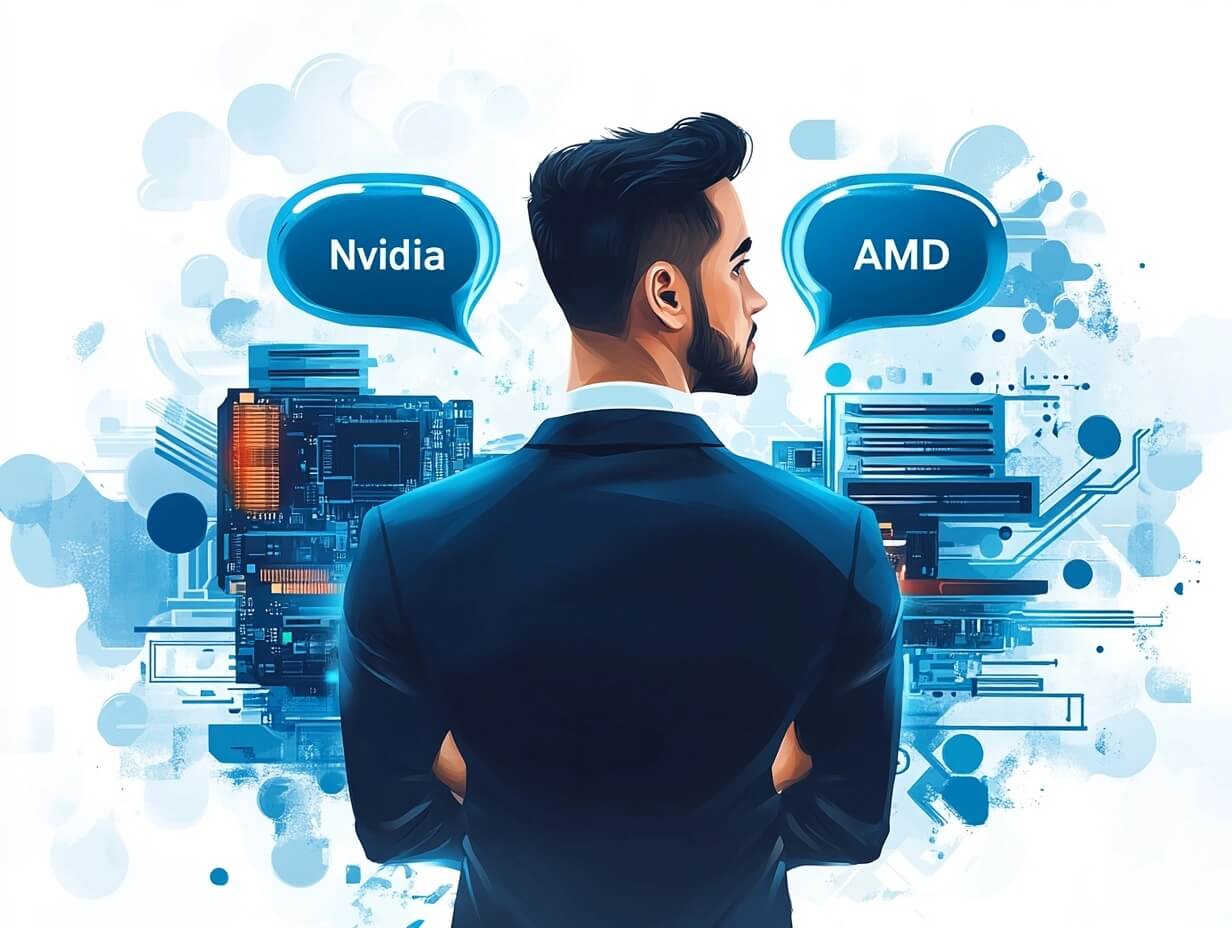What do GPUs bring to business and AI?
In 2025, GPUs have evolved far beyond their roots in gaming or flashy visual effects—they’ve become the beating heart of innovation across industries, powering everything from cutting-edge science to everyday business operations. Here at King Servers, we’re not just onlookers; we’re right in the thick of it, watching our clients harness these technological beasts to solve problems, seize opportunities, and push boundaries like never before. What started as a niche tool for rendering high-res graphics has morphed into a game-changer that’s reshaping how we think about computation itself. Whether it’s a researcher decoding the secrets of DNA, a retailer predicting tomorrow’s hot product, or a designer crafting a virtual world from their living room, GPUs are the unsung heroes making it happen—faster, smarter, and more efficiently than ever.

From Gaming to Global Innovation
The shift didn’t happen overnight. A decade ago, GPUs were mostly the domain of gamers and animators, celebrated for their ability to churn out stunning visuals at breakneck speed. But as data exploded and computational demands skyrocketed, these graphics cards proved they could do so much more. Their knack for parallel processing—handling thousands of tasks at once—caught the eye of scientists, developers, and business leaders alike. Suddenly, what used to take a room full of CPUs humming for weeks could be tackled by a single GPU-powered server in a fraction of the time.
It’s not just about raw power, though; it’s about accessibility. At King Servers, we’ve made it our mission to put this tech into the hands of anyone with a big idea—whether you’re a scrappy startup, a sprawling enterprise, or a university lab running on a shoestring budget. Renting a server with an H100 or MI300X doesn’t require a fortune; it’s a practical choice that levels the playing field.
To illustrate, let’s compare the key specs of the latest GPUs: memory capacity and bandwidth. These parameters are critical for AI workloads and large models.
Real-World Impact Across Environments
Take a moment to picture the scope. In labs, GPUs are crunching terabytes of data to unlock cures or predict climate shifts. In boardrooms, they’re sifting through customer habits to spot trends before the competition does. On factory floors, they’re keeping production lines humming by analyzing video feeds in real time. And in homes, they’re letting creatives and engineers work on heavyweight projects without needing a high-end rig under their desk.
We see it every day: clients who once thought their goals were out of reach now hitting them head-on, thanks to the raw horsepower and flexibility GPUs bring. This isn’t hype—it’s reality, backed by stories from the front lines of our customer base, from small teams to global players.
What to Expect in This Article
So, in this article, we are diving into five key areas where GPUs are making waves: science and research, video and graphics, AI, analytics and big data, and remote work via VDI. Each section pulls from real examples we’ve witnessed at King Servers—cases where our clients turned challenges into wins with the right tools.
It’s not just about the tech; it’s about what it unlocks for people and businesses. Whether you’re curious about how these machines work their magic or looking to jump in yourself, stick with me. Let’s explore how GPUs in 2025 are rewriting the rules—and how you can get in on it too.

NVIDIA vs. AMD: Which One to Choose?
Now let’s compare NVIDIA and AMD. Both brands are battling for leadership in 2025—and here’s what we’ve observed.

Science and Research
Genomics, Climate, Physics, Chemistry, Finance
Modern science without GPUs is like a telescope without a lens. At King Servers, we’ve seen research teams come alive the moment they get their hands on powerful graphics cards. Tasks that once felt impossible now wrap up in days. Genomics, climatology, physics, chemistry, financial analytics—everywhere you look, computations are getting trickier, and datasets are ballooning. Where supercomputers costing millions were once the only option, today you can rent a GPU server from us and hit the ground running.
Working with AlphaFold, Simulations, Numerical Calculations
Take genomics, for example. Analyzing DNA and proteins means sifting through terabytes of data, modeling millions of variables. Tools like AlphaFold, which predict protein structures, crawl along for weeks on regular CPUs. GPUs flip that script. One of our clients, a small university biology department, rented a server with an NVIDIA H100 and generated a complex protein structure overnight. Without GPUs, they’d have been waiting a week or more, burning through grant money on coffee for late-night lab sessions.
Or consider physics: simulating plasma for a fusion reactor involves solving billions of equations at once. A researcher from a physics institute told us how they ran a model on an MI300X server in three days—on their old cluster, it would’ve taken a month. In chemistry, GPUs model molecular reactions; in finance, they forecast markets with Monte Carlo simulations. And climatology? That’s a whole other beast: massive atmospheric models where every data point requires millions of calculations. One university rented an AMD Instinct MI300X server from us and built a 50-year climate forecast in a week. Without GPUs, they’d still be crunching numbers.
Examples: Institutes, Universities, R&D Teams
We’re constantly amazed by how science lights up with GPUs. Recently, we chatted with a team from a small genetics institute. They grabbed an H200 server from us to study how mutations affect genes. Experiments that used to take two weeks now finish in two days, with sharper results.
Another case: an R&D unit at a pharmaceutical company. They were hunting for new drug molecules, ran docking simulations on a server with twin H100s, and found three promising candidates over a weekend. Without GPUs, they’d have been at it for months.
Universities are a big one too. A climate research center modeled tsunamis on an MI300X, mapping coastal risks in five days—on CPUs, that would’ve taken a quarter. And then there’s a finance lab forecasting market volatility. With an RTX 6000 Ada, they cut calculations from three days to six hours. This isn’t just speed—it’s a new era for research.
To better understand how GPUs are changing the game, here’s a comparison of real-world task acceleration from our clients. You’ll see where GPUs deliver the most impact.
Why Are GPUs So Critical for Science?
Today’s scientific challenges aren’t just complex—they’re massive. Molecular dynamics simulations, tsunami forecasts, digital twins of accelerators, or atmospheric models—CPUs choke on these. Geneticists process terabytes of sequencing data to understand mutation impacts. Physicists build virtual reactors to avoid blowing up real ones. Climatologists crunch billions of data points to predict hurricanes or droughts. On standard servers, these projects drag on for months or years, with grants drying up before results arrive.
GPUs change the game: a server with graphics cards shrinks timelines to days or even hours. One client put it perfectly: “With GPUs, we can finish a thought while it’s still fresh.” And it’s true—science is getting faster and more vibrant.
Renting as a Game-Changer
The best part? You don’t need a massive budget to tap into this power. Universities, labs, small grant projects—everyone can rent a GPU server from King Servers and work at the level of top-tier supercomputers.
A bioinformatics startup recently rented a server from us for a month to test a hypothesis. They met their deadline, secured a grant, and are now planning their next project.
Another example: a university that couldn’t afford its own hardware. They rented an H100 server for a quarter, ran a series of experiments, and published in a top journal. This isn’t just cost-saving—it’s a chance for science to be more accessible and impactful. GPUs tear down barriers, and we get a kick out of seeing our servers help spark new discoveries.

Video and Graphics
Video Surveillance, Recognition, Streaming
In 2025, GPUs are absolute wizards at handling video and graphics, and we at King Servers see how they’re reshaping these tasks. They’re not just for flashy games or movies anymore—they’re about real-world business scenarios where every second counts.
Take surveillance: GPU-powered neural networks analyze live camera feeds on the fly. They count people, track movements, spot anomalies—all in real time. One client, a retail chain, set up an RTX 6000 Ada server to monitor queues. Now they know instantly where crowds are forming and open extra registers. Their manager said it used to take half a day to analyze footage—now data rolls in immediately, boosting sales because customers don’t bail due to long lines.
Another example: warehouse logistics. GPU-driven cameras recognize boxes, check their condition, and even read barcodes, speeding up operations threefold. And then there’s security: one client used an H100 server to catch suspicious activity in a parking lot—everything from theft to abandoned bags. These aren’t just cameras—they’re the sharp eyes of a business.
Rendering Ads and 3D Content
When it comes to graphics, GPUs are a lifesaver. The visual studios we work with often rent our servers for rendering ads, 3D animations, and effects. One client—a small animation studio—used to spend a week rendering a 30-second TV spot. They switched to a server with dual H100s, and now it’s done in a day. They’re even taking on more gigs because tight deadlines don’t scare them anymore.
Another case: a design firm creating 3D models for the auto industry. They rented an MI300X server from us, and complex scenes with shadows and reflections now render overnight instead of three days. It’s not just faster—it’s about hitting deadlines and wowing clients.
Then there’s post-production: color correction, VFX, editing—all buttery smooth with GPUs. One studio told us that with an H200 server, they delivered a feature film two weeks ahead of schedule, leaving their client thrilled.
Examples: Studios, Metaverses, Manufacturing
The use cases are endless, and I’m always blown away by how varied they are. Take metaverses—a hot topic that’s dead without GPUs. One startup tested a virtual office on our MI300X server. They render graphics server-side, and employees connect from basic laptops, roaming a 3D space like it’s real life. It’s not a gimmick—they hold meetings and presentations there.
Another example: manufacturing. A factory we work with uses an RTX 6000 Ada server for quality control. Cameras scan parts on the assembly line, and GPUs spot defects—cracks, chips, irregularities—in real time. Humans used to do this; now machines handle it in seconds, cutting errors by 15%.
Then there’s architecture. One firm rented an H100 server to show clients interactive 3D building models. Clients can “walk” through the design, tweak lighting or materials—all lag-free. It’s impressive and it sells.
Here’s how different types of analytics tasks are distributed across GPU usage. These are real stats based on our client cases:
Why Are GPUs So Vital Here?
GPUs are the beating heart of video and graphics work, and we keep telling our clients this. They handle the heavy lifting, from processing streams to rendering intricate scenes. Without them, retailers wouldn’t see queues live, studios would churn out videos for months, and VR projects would stay pipe dreams.
One client summed it up: “With GPUs, we’re not just faster—we’re doing things we couldn’t before.” And it’s true. Video analytics systems powered by neural networks don’t just count people—they gauge emotions on faces, helping stores see if customers are happy.
Or take streaming: a platform rented our L40 server to beam 4K video to hundreds of thousands of viewers without a hitch. In industry, GPUs verify satellite imagery for mapping—what used to take weeks now takes hours. All this is possible thanks to the graphics cards we offer for rent.
Renting as the Key
The coolest part? You don’t have to shell out millions for this hardware. At King Servers, you can rent a GPU server for any duration and task. Need to render an ad? Grab an H200 for a week. Want video analytics? RTX 6000 Ada for a month. Metaverse project? MI300X for a quarter.
One client, a marketing agency, rented an H100 server to create a 3D tour for an expo. They nailed the project in three days, landed a contract, and returned the server. That’s the kind of flexibility you couldn’t dream of before.
GPU servers break down barriers: studios, startups, factories—everyone can work with top-tier video and graphics. And we’re here to set it up and get you going, so you don’t waste time on tech headaches.

AI: From Training to Inference
Training Neural Networks 3–5 Times Faster
Artificial intelligence without GPUs is like a car without an engine, and we see it every day at King Servers. Training neural networks is a beast, especially for heavy stuff like speech recognition or image analysis. On regular CPUs, even a mid-sized model can take weeks or months. GPUs turn that around completely.
We watched one client—a warehouse software developer—slash their system’s training time from two weeks to three days just by hooking up an NVIDIA H100 server. They hit their deadline and still had time to celebrate. Another case: a startup building voice assistants. They rented an AMD MI300X server from us, and their model, which used to take nearly ten days, was ready in 24 hours. This isn’t just 3–5 times faster—it’s saving time, stress, and cash.
One team member even joked, “With GPUs, we grab a coffee while the model trains, not a week’s worth of pizza.” And it’s true—graphics cards turn long waits into quick wins.
Real-Time Request Processing with Zero Lag
But training is just the start. Once the model’s ready, it needs to “serve”—handling user requests in real time, aka inference. This is where GPUs really flex. A single accelerator can juggle tens of thousands of requests per second, whether it’s translating text, generating replies, or crunching data.
We’ve got a client—an online store—that launched a recommendation system on an H100 server. Their site now dishes out personalized offers in milliseconds, boosting conversions by 10%. Another example: a company making chatbots for customer support. They rented an MI300X server from us, and their bot responds instantly, even during peak hours with thousands of queries.
It’s not just speed—it’s a competitive edge. One developer told us, “Without GPUs, users would wait three seconds for a reply—now they don’t even blink.” It works—customers are happy, and the business grows.
Examples: Voice Assistants, Chatbots, Recommendations
Let’s look at some real-world cases we’ve seen. Voice assistants are a big deal. One firm set up an H200 server for theirs, and it now recognizes commands, translates speech, and responds lag-free—in English, Russian, you name it. They say active users jumped 15% because nobody likes waiting.
Chatbots are another story. A client in the travel industry launched a bot on an RTX 6000 Ada server. It helps pick tours, answers questions, even cracks jokes—all in real time. Their sales climbed 8% because people stick around instead of leaving.
Recommendations? An online streaming service rented an MI300X server to suggest movies based on viewer tastes. The system analyzes behavior and delivers picks in a second, increasing watch time by 20%.
Then there’s image generation. A startup tested an interior design model on an H100: users upload a room photo, and the AI churns out furniture options in seconds. It’s not just cool—it sells.
Why Are GPUs So Crucial for AI?
GPUs are the key to any AI task, and I keep telling clients this. Modern neural networks—for speech, text, computer vision—demand massive compute power. Training a language model like GPT on a CPU could take months; with an H100 or MI300X, it’s days.
One client said, “Without GPUs, we’d still be stuck on our last project—now we’ve launched three more.” That’s time saved, and for developers, time is gold. We’ve seen a five-person team on a GPU server do what used to need an entire data center.
Plus, GPUs handle loads CPUs can’t touch. Take video processing for facial recognition—without graphics cards, it’s too slow and pricey. With them, it flies, and projects hit release on time.
Ready to Upgrade to Modern Server Infrastructure?
At King Servers, we offer both AMD EPYC and Intel Xeon servers, with flexible configurations for any workload — from virtualization and web hosting to S3-compatible storage and data clusters.
- S3-compatible storage for backups
- Control panel, API access, and scalability
- 24/7 support and assistance with configuration
Registration Result
...
Create an Account
Quick signup to access infrastructure
Inference—Where GPUs Shine
After training comes the fun part: inference. This is when the model answers user requests, and GPUs show off. A single accelerator can manage thousands of streams at once.
We’ve got a client with a text translation platform. They set up an H200 server, and their system now translates documents into 50 languages in real time—emails to books.
Another example: action prediction. An electronics store uses an MI300X to guess what a customer will buy while they browse the site. It’s not magic—it’s GPU power.
Or take text generation. A company launched an AI on an H100 to write product descriptions. Copywriters used to spend hours; now the model spits out compelling text in seconds.
This isn’t just faster—it’s business growth: sales, conversions, response speed. One client admitted, “With GPUs, we’re outpacing competitors, and the numbers prove it.”
Renting—The Path to AI
The best part? You don’t need to drop millions on hardware. At King Servers, you can rent a GPU server and start right away. Want to train a model? Grab an H100 for a week. Need inference? MI300X for a month.
One client—a marketing agency—rented an H200 to test AI for ads. They built a pilot in three days, won a deal, and returned the rig. That’s flexibility you couldn’t dream of before.
With us, GPUs aren’t a luxury—they’re a tool for anyone who wants AI now.

Analytics and Big Data
Processing Telemetry, Logs, Transactions
In 2025, businesses are drowning in data, and we see it every day at King Servers. Online orders, app logs, sensor telemetry, transactions—it’s pouring in like a flood. Without the right tools, making sense of it is like finding a needle in a haystack. GPU servers are a lifeline. They tackle massive datasets and do it lightning-fast.
For instance, one client—an IoT device operator—collects telemetry from thousands of sensors: temperature, pressure, speed. On their old gear, analysis took a day; now, with an H100 server, reports are ready in a couple of hours.
Another case: log processing. An IT company analyzes millions of entries to catch system glitches. With an MI300X GPU, they cut the time from three days to six hours. Transactions? A fintech startup checks millions of payments daily on an RTX 6000 Ada server—all in real time. This isn’t just speed—it’s keeping your finger on the business’s pulse.
Speeding Up SQL Queries, Predictive Analytics
GPUs aren’t just about raw data—they’re about smart analytics. Complex SQL queries, clustering, visualization, predictions—they all fly on graphics cards.
One retail client told us they used to wait a day to tally regional sales. Now, with an H200 server, it’s two hours, and the report’s done. SQL queries that dragged down databases now run in parallel, with results almost instant.
Predictive analytics? That’s a whole other ballgame. One company forecasts electronics demand by studying buyer behavior. With an MI300X GPU, they spot trends in a day, not a week, and stock up before the rush. Another example: marketing. An agency segments audiences for campaigns on an H100 server: millions of profiles split into groups in an hour, and ads hit the mark. These aren’t just numbers—they’re insights that push businesses forward.
Examples: Demand Forecasting, Routes, Credit Risks
Let’s break down how it works in practice. One logistics firm saved 8% on fuel by forecasting routes on an RTX 6000 Ada server. They factored in traffic, weather, and truck loads—calculated overnight instead of three days. Now their rigs roll faster and cheaper.
A supermarket chain’s another story. They analyze millions of purchases to see what sells where and when. With an H200 server, it takes two hours instead of a day, keeping shelves stocked.
Banks? A financial firm calculates credit risks on an MI300X, checking transactions, customer behavior, and external factors—scoring in minutes, not hours. One analyst said, “With GPUs, we catch risks before they’re problems.”
Then there’s telecom. An operator predicts network load by analyzing terabytes of logs. With an H100, they spot peaks in an hour and reroute resources to keep connections solid. That’s real savings and better quality.
Why Are GPUs So Vital for Analytics?
Data in 2025 isn’t just spreadsheets—it’s mountains of info: sensors, behavioral analytics, transactions. Processing it on CPUs is torture. GPUs turn drudgery into a blazing-fast process. They crunch millions of rows in parallel, build models, and deliver results where CPUs would choke.
We saw one company try log analysis on an old server—a week wasted. They switched to GPUs, and it was done in a day. It’s like swapping a calculator for a supercomputer. One client joked, “With GPUs, I sip coffee while data crunches, not order dinner.” And it’s true—graphics cards make analytics lively and clear.
Marketers segment audiences, retailers predict demand, logisticians map routes—it’s all scalable and quick.
Renting—The Key to Success
The best part? You don’t need to build a data center. At King Servers, you can rent a GPU server and dive in. Need demand forecasting? Grab an H200 for a week. Want risk analysis? MI300X for a month.
One client—a logistics operator—rented an H100 to test routes. They built a model in three days, saved on fuel, and returned the rig. Another—a fintech firm—rented an RTX 6000 Ada for a quarter to launch an anti-fraud system. Now they catch crooks on the fly and plan to scale.
That’s flexibility we used to dream of. GPUs with us aren’t a luxury—they’re a tool for anyone who wants analytics now. We even help with setup so you don’t sweat the tech details.

VDI and Remote Work
Design, 3D Modeling, Editing—From Home
Remote work in 2025 isn’t just a trend—it’s a must, and we at King Servers see companies scrambling to make it smooth and productive. Designers, engineers, editors—they all need heavy apps like AutoCAD, Blender, or Premiere Pro. But lugging a high-end workstation home? No way. That’s where VDI (virtual desktop infrastructure) with GPUs steps in.
Picture this: all the graphics crunching happens on a server, and you connect from a basic laptop or even a tablet, working like you’re on a top-tier PC. One client—an architecture firm—rents an RTX 6000 Ada server from us. Their team builds 3D building models from home, and it runs as smoothly as if they were in the office on high-end rigs. Their boss told us, “We used to spend hours rendering—now the team does it over coffee.” It’s not just convenience—it’s a new level of freedom for teams.
Secure, Fast, No Need for Local Powerhouses
The big win with GPU-powered VDI? You don’t have to buy pricey machines for every employee. I hear clients say all the time, “We can’t hand out million-dollar PCs.” And you don’t need to! A server with a graphics card like RTX 6000 Ada or L40 handles everything.
Graphics process in the data center, and users just get the final image—no lag, no crazy hardware demands at home. One engineer connected to our H100 server from a decade-old laptop and breezed through complex Revit models. Speed? Like he was in the office on a beastly rig.
Security? All data stays on the server—nothing leaks, even if the laptop goes missing. A design firm told us that after switching to GPU VDI, they stopped worrying about project theft. “Everything’s locked down, and the team works from anywhere,” they said. It’s protection and savings rolled into one.
Examples: Architecture, Studios, Geodesy
Let’s see who’s using this. Architecture firms are a classic. One rents our RTX 6000 Ada server, and their ten-person team works on projects from different cities. An architect showed me how he spins a 3D house model from a café—lag-free, with shadows and textures.
Another case: a video production studio. They grabbed an L40 server to edit in Premiere Pro and After Effects. Editors used to wait hours for renders; now it’s minutes, all from home.
Then there’s a geodesy company. They stream GIS maps from an H200 server to field engineers. Maps with elevations and layers load instantly, even on weak laptops in the middle of nowhere. One geodesist said, “With GPUs, I see data faster than I can brew tea.”
And interior designers—they render Blender scenes on an MI300X server, showing clients real-time options. It’s not just work—it’s a wow factor for customers.

Why Are GPUs and VDI So Essential?
Servers with graphics cards like RTX 6000 Ada or H100 are the backbone of remote graphics work. Without them, companies either go broke buying hardware or suffer through lag.
Data-center GPUs handle the heavy stuff: rendering, modeling, video processing. Thanks to tech like NVIDIA GRID or AMD MxGPU, one card splits its power among users—everyone gets their slice.
We had a client hook 15 designers to a single H200 server. Each got their own virtual machine with graphics, and they all worked seamlessly. I was amazed at how smooth it was—like everyone had a high-end PC at home.
Best of all, no fiddling with local gear. One editor told us, “I used to haul a tower home—now I grab a laptop and work from the park.” That’s the freedom GPUs bring to teams.
Renting—A Business Lifesaver
The coolest thing? No need to build a data center or buy hardware. At King Servers, you can rent a GPU server and launch VDI tomorrow. Need a design project? Grab an RTX 6000 Ada for a month. Editing video? L40 for a week.
One client—an animation studio—rented an H100 for a quarter to finish an ad. They delivered early and saved on gear. Another—an engineering firm—took an MI300X to stream blueprints to a team across three cities. Now they work in sync, like they’re in one office.
That’s flexibility we used to dream of. We even help tailor it to your needs—software, access, you name it. One client said, “With you, I don’t think about hardware—I just work.” And that’s the truth—our GPU servers make remote work fast, secure, and accessible.

🚀 Wrap-Up
In 2025, GPUs aren’t just hardware—they’re a catalyst for progress. They speed up scientific breakthroughs, make analytics instant, take AI to new heights, revolutionize video and graphics, and turn remote work into a seamless, secure experience.
At King Servers, we see how these tools empower clients—from startups to big players—to solve problems faster and smarter. Renting GPU servers levels the playing field: you don’t need millions to access top-tier power.
Ready to give it a shot? Swing by our site, grab a server for a test run, and see how graphics cards can change the way you work. It’s not just about speed—it’s about unlocking possibilities waiting for you right now.

























